Article and photos by Joe Sapia
Note: The yard references are to my house in the section of Monroe between Helmetta and Jamesburg in South Middlesex County. My yard is in a Pine Barrens outlier on the Inner Coastal Plain, the soil is loamy, and my neighborhood is on the boundary of Gardening Zones 6b (cooler) and 7a (warmer). Notes and photographs are for the period covered, unless otherwise noted.
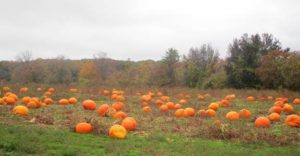
Pumpkins and fall foliage, both taking a last stand for the season, at the Red Wagon Farm Market on Route 33 and Smithburg Road/Route 527-A in Manalapan, Monmouth County.
SNOWBIRDS: I saw the first “snowbirds,” or dark-eyed juncos, “Junco hyemalis,” of the season on Tuesday, November 7, Election Day, around sunrise at St. James Cemetery in Monroe, Middlesex County. The birds are easy to identify by their gray tops and white undersides – “gray skies above, snow below” – and the white edges of their splayed tails as they take off. My rule of thumb is to look for these birds around Halloween, October 31, arriving for the cold weather from as close as the high ground of North Jersey or Pennsylvania and as far away as Canada. Around my yard, I look for these small birds on the ground under the bird-feeder or in bushes. I will see them around my yard to about mid- to late April.
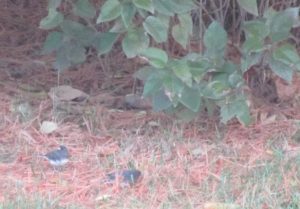
I saw the first “snowbirds,” or dark-eyed juncos, of the season Tuesday, November 7, Election Day, at St. James Cemetery in Monroe, Middlesex County. These birds arrive from the north for the cold-weather season.
VOICES FROM AFIELD, MORE WINTER BIRDS: Diane Larson, a long-time gardening mentor, checked in on the afield side, regarding Beaver Dam Creek in Brick, Ocean County. “Another bird sign of winter – the buffleheads (“Bucephala albeola’’) and mergansers (genus “Mergus”) arrived in Beaver Dam Creek right on schedule – saw them Saturday (November 4) for the first time. We also have otters (“Lutra Canadensis”). They are very elusive, but we’ve seen them and heard them splashing in the water around 8:00 p.m. one night (during) the last week of October. We went outside and tried to see them, but they swam away. All we saw was their wake and heard their grunts.”
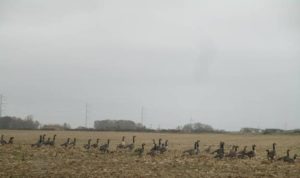
Canada geese, “Branta canadensis,” on the Skeba Farm in the Applegarth section of Monroe, Middlesex County.
BIRDS IN MY YARD: As I was doing yardwork, birds were feasting on corn hearts at my backyard bird-feeder: dark-eyed junco, “Junco hyemalis”; mourning dove, “Zenaida macroura”; tufted titmouse, “Baeolophus bicolor”; and Carolina chickadee, “Poecile carolinensis.”
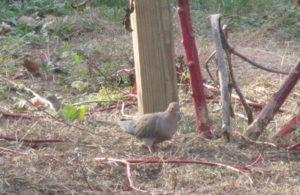
A Mourning Dove at my Backyard Bird-feeder

A Tufted Titmouse at my Backyard Bird-Feeder
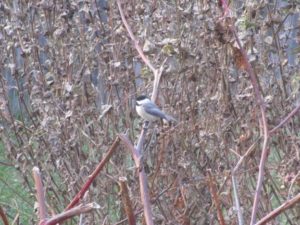
A Chickadee at my Backyard Feeder
GARDEN AND YARD: As I cut the lawn, hopefully for the last time of the year, I smelled wild onions I had mowed down. A bittersweet scent – one pointing back at the year’s peak of vegetable growing, one pointing to a gardening season that lingers. The Jamesburg-to-New Brunswick area of Middlesex County got down to about 20 degrees on the Friday-Saturday, November 10-11, overnight, pretty much bringing an end to the warm weather gardening season. However, I did find a few cherry tomatoes in my garden. (I have a cool weather crop of carrots planted. So, I am hoping for some kind of harvest.) So, this week, I cut the lawn, dumped my last barrel of gardening water, and mowed down the garden, except for the carrots. As for the yard work, I try to get that all done by Thanksgiving.
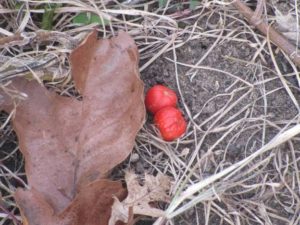
I found these cherry tomatoes in my garden. The top one was in good condition and I popped it into my mouth right in the yard and ate it.
VOICES FROM AFIELD, NO. 2, LINGERING SPRING: Last week, I mentioned I thought I heard the call of a spring peeper treefrog, “Pseudacris crucifer,” at Farrington Lake on the boundary of South Brunswick, East Brunswick, and North Brunswick in Middlesex County. They are normally early spring callers. Jean Montgomerie, an environmental scientist who lives in Freehold and works in the Pine Barrens, said, “Those were spring peepers; I heard them last week too.” Spring, in the form of fall, is playing itself out again, this year.
NIGHT SKY: With the cold spell at the end of the week, I stood in my yard between about 10:30 p.m. and 11:30 p.m. and looked at the night sky. With the temperature at about 23 degrees and very little moisture in the air (with a dewpoint of about 8 degrees), it was one of the clearest night skies I recall, with great views of Auriga (overhead/east); Pleiades, or Seven Sisters (overhead); Orion (southeast); the Great Square of Pegasus (southwest); Cassiopeia (northwest); and the North Star. Take advantage of cold, dry fall and winter overnights. Get a revolving star chart, turn off the outside lights, go outside and acclimate your eyesight to the darkness, and look into the night sky.
THE MOON: The moon is waning from the Full Frost Moon of the November 3-4 overnight. The next full moon is the Long Night Moon on the December 2-3 overnight.
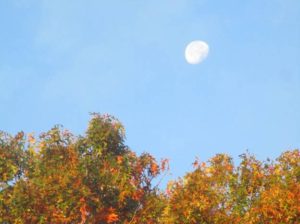
The morning moon, with the changing colors of the fall foliage underneath, at St. James Cemetery in Monroe, Middlesex County. The moon is waning from the Full Frost Moon of the November 3-4 overnight. The next full moon is the Long Night Moon on the December 2-3 overnight.
FALL FOLIAGE: The changing colors of fall foliage are all over the place – some past full color, some peaking, some yet to come. I take the colors as they come, rather than concentrating on a peak.
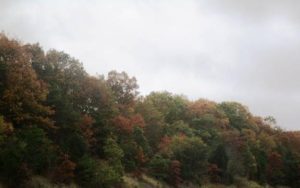
The changing colors of the fall foliage along Interstate 195 in Jackson, Ocean County.
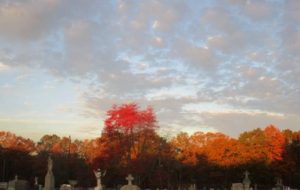
The rising sun’s light hits the top of the trees, lighting up the fall colors, at St. James Cemetery in Monroe, Middlesex County.
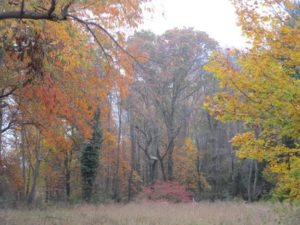
The changing colors between Davidson Mill Park and Pigeon Swamp in South Brunswick, Middlesex County.
DRIVE-BY NATURALIST, RED-TAILED HAWK: As I was returning home from my normal Sunday routine of lunch at the Hightstown Diner in Mercer County, I crossed the Millstone River on the boundary of Cranbury, Middlesex County, and East Windsor, Mercer County. On the Cranbury side, a large bird flew out of the trees, then low along the roadway – a red-tailed hawk, “Buteo jamaicensis.” I cranked off a shot on my camera. Not a good shot, but that is photojournalism – you take what you get, because the news does not necessarily stop for the journalist. The photo, at least, puts in perspective how low the bird was.
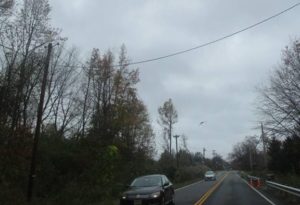
A red-tailed hawk flies low along a roadway on the boundary of Cranbury, Middlesex County, and East Windsor, Mercer County.
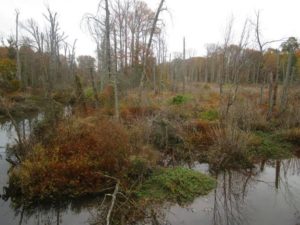
The Millstone River on the boundary of Cranbury, Middlesex County, and East Windsor, Mercer County.
VOICES FROM AFIELD, NO. 3, DEER RUT: I continue seeing normally hidden male deer, “Odocoileus virginianus,” because it is the mating season, or rut. This week, I saw one in southern Monroe, Middlesex County, at night. Then, as I was driving to work one morning in daylight, a deer bolted across a paved road in the Jamesburg Park Conservation Area in the Pine Barrens around Helmetta, Middlesex County. I did not get a good look at the deer, but, based on the way it bolted across the street and because I saw no others, my guess is it was a buck. Paul Migut checked in from South River, Middlesex County: “Spotted buck behind my firehouse. He’s been chasing two does around here.” Again, be careful driving during the rut, which should last until about mid-December.
CLOUDS: This week’s cloud shots are from St. James Cemetery in Monroe, Middlesex County. My family has had a plot there for more than 100 years, since my maternal grandfather, Michael Onda, died in 1917, October.
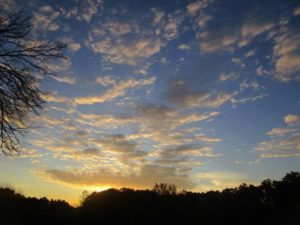
Clouds over St. James Cemetery in Monroe, Middlesex County.

More clouds from St. James Cemetery in Monroe, Middlesex County.

And more clouds from St. James Cemetery in Monroe, Middlesex County.
VOICES FROM AFIELD, N0. 4, SWIMMING RIVER: Rik van Hemmen, sailor and advocate for the Navesink River watershed, Monmouth County, checked in: “Two weeks ago, just before I hauled my Sea Bright skiff for the winter, we had a perfect tide going up the Swimming River with friends who had never done it before. As is common, it blew their minds to see all this natural beauty.”

Fall on the Swimming River in Monmouth County. (Photograph copyright 2017 by Rik van Hemmen.)
OCEAN TEMPERATURES: Atlantic Ocean temperatures on the New Jersey coast were about 50 degrees to 53 degrees over the November 11-12 weekend.
SUNRISE/SUNSET: For November 12, Sunday, to November 18, Saturday, the sun will rise about 6:40 to 6:45 a.m. and set about 4:35 to 4:40 p.m. For November 19, Sunday, to November 25, Saturday, the sun will rise about 6:50 to 6:55 a.m. and set about 4:35 p.m.
WEATHER: The National Weather Service forecasting station for the area is at http://www.weather.gov/phi/.
IN THE BACKYARD: As I was wrapping up this week’s “Notes from Garden and Afield,” I took a soda break. While in the kitchen, I grabbed four gourds I had on display on the table, opened the back door, stood on the back porch, and threw the gourds across the lawn into the garden. I threw one into a pitch pine, “Pinus rigida,” bordering lawn and garden. A bird must have been in the tree, because a large bird flew out and past me eye-high. Wow! On that note….
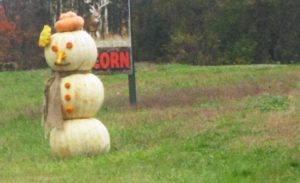
Say, good night, Pumpkin Person. (A pumpkin person at the Red Wagon Farm Market on Route 33, Manalapan, Monmouth County.)
Joe Sapia, 60, is a lifelong resident of Monroe — in South Middlesex County, where his maternal family settled more than 100 years ago. He is a Pine Barrens naturalist and a gardener of organic vegetables and fruit, along with zinnias and roses. He draws inspiration on the Pine Barrens around Helmetta from his mother, Sophie Onda Sapia, who lived her whole life in these Pines, and his Polish-immigrant grandmother, Annie Poznanski Onda. He gardens the same backyard plot as did his Grandma Annie and Italian-American father, Joe Sr. Both are inspirations for his food gardening. Ma inspires his rose gardening. Joe is a semi-retired print journalist of almost 40 years. His work also is at @JosephSapia on Twitter.com, along with Facebook.com on the Jersey Midlands page.
Article and photos by Joe Sapia
Note: The yard references are to my house in the section of Monroe between Helmetta and Jamesburg in South Middlesex County. My yard is in a Pine Barrens outlier on the Inner Coastal Plain, the soil is loamy, and my neighborhood is on the boundary of Gardening Zones 6b (cooler) and 7a (warmer). Notes and photographs are for the period covered, unless otherwise noted.
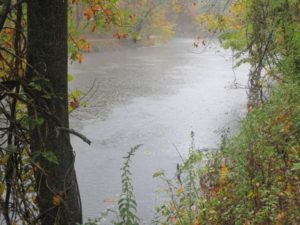
Nor’easter rain pelts the Delaware and Raritan Canal at Kingston, which overlaps the boundary of Franklin, Somerset County, and South Brunswick, Middlesex County. This photograph was taken on the Somerset County side of Route 27.
NOR’EASTER: The Sunday-Monday, October 29-30, nor’easter dropped large amounts of rain throughout the Jersey Midlands. The National Weather Service unofficial high totals from weather stations in the Jersey Midlands portion of seven counties: Hunterdon, up to 4.91 inches in High Bridge; Somerset, up to 4.5 inches in Bernards; Middlesex, up to 3.79 inches in northeast South Brunswick; Monmouth, up to 4.74 inches in West Long Branch; Ocean, up to 5.45 inches in Berkeley; Burlington, up to 4.62 inches in Roebling; and Mercer, up to 5.42 in west Princeton.
The nor’easter also brought reported maximum wind gusts of: Hunterdon, 45 miles per hour at Frenchtown; Middlesex, 52 MPH in the Raritan River/Perth Amboy area; Monmouth, 49 MPH at north Long Branch; Ocean, 58 MPH in the Beach Haven area; Burlington, 47 MPH at Jobstown; and Mercer, 40 MPH at Mercer County Airport.
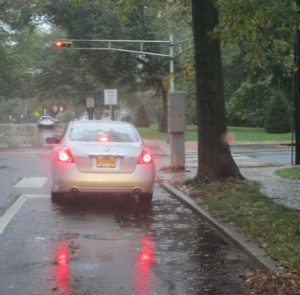
Water pools on a roadway in Princeton, Mercer County, during the nor’easter Sunday, October 29.
NOR’EASTER, BEFORE AND AFTER: Before the Sunday-Monday, October 29-30, nor’easter, all seven Midlands counties had a deficit of rainfall over the last three months. After the nor’easter, only Hunterdon and Mercer have deficits. According to National Weather Service, three-month rainfalls as of Thursday, November 2, were: Hunterdon, 10.7 inches total over the last three months, minus 1.8 inches; Somerset, 12.4 inches, plus .2 inches; Middlesex, 12.0 inches, even; Monmouth, plus .2 inches; Ocean, 12.0 inches, plus .7 inches; Burlington, 11.8 inches, plus .2 inches; and Mercer, 10.2 inches, minus 1.8 inches.
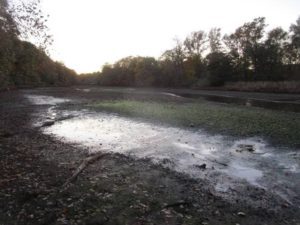
Farrington Lake – here, on the boundary of South Brunswick and East Brunswick looking to North Brunswick, all in Middlesex County – in the days before the Sunday-Monday, October 29-30, nor’easter.
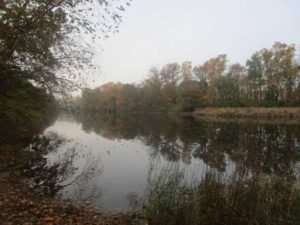
The same view of Farrington Lake in the days after the nor’easter.
FALLEN LEAVES ON ROADWAYS: Motorists, be careful of braking with fallen leaves on the roadway, especially in wet conditions.
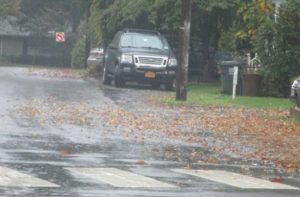
Leaves cover a roadway in the Kingston section of Franklin, Somerset County, during the October 29-30 nor’easter.
FALL FOLIAGE: The fall colors have really brightened, although there is still much green out there and a lot that has already turned color. I am thinking we are in the midst of our (erratic) peak, so enjoy it while it lasts.
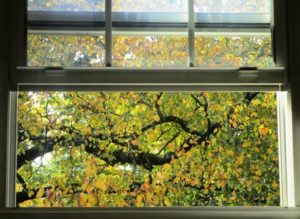
The changing colors of the fall foliage in New Brunswick, Middlesex County, as seen through the window of the Rutgers University Plangere Writing Center.
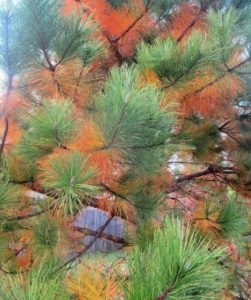
Shattering two myths: One, pine trees are evergreens, but they do shed needles. Here, a pitch pine, “Pinus rigida,” the most common pine of the New Jersey Pine Barrens. This one is in my backyard in Monroe, Middlesex County, but transplanted from the wilds of the Pine Barrens of Monmouth County. Two, the Pine Barrens are not barren. Actually, the Pines are a great place to see the changing colors of the fall, contrasting with the greens of pitch pines and other evergreens.
DEER RUT: As I have mentioned, I am seeing something I do not normally see – adult male deer, “Odocoileus virginianus.” But it is the mating season, or rut, so bucks are moving. On the night of Wednesday, November 1, I saw a buck as I drove through an East Brunswick section of the Jamesburg Park Conservation Area. He trotted into the woods. We appear to still be in the first phase of the rut – bucks following female deer in search of receptive does. The second phase will be mating, the third phase being the rut winding down – the rut lasting until about mid-December. With sex-crazed deer running around, be careful driving.
VOICE FROM AFIELD, JOAN GETAZ ZUMOFF: I still not have seen any “snowbirds,” or juncos, “Junco hyemalis,” at my house in Monroe, Middlesex County. But I expect them any day down for the colder weather from probably as far north as Canada. Actually, they are likely around already and I just have not seen any yet, because Joan Getaz Zumoff checked in just below the Midlands — from Gloucester Township, Camden County, where she had a first sighting Oct. 27. My rule of thumb for snowbirds at my house is around Halloween, October 31. But this has been a wacky year with the weather.
IS IT FALL YET?: Depending on the day, it could be frosty or summer-like. This week, I was shooting photographs at Farrington Lake in Middlesex County. At the part of the lake on the boundary where North Brunswick, East Brunswick, and South Brunswick meet, I am pretty sure I heard a spring peeper treefrog, “Pseudacris crucifer.” The normal time to begin hearing their calls is around early March – that harbinger of spring that sounds like sleigh bells coming from swamps – and, then, they are pretty much done as the spring warms up toward summer.
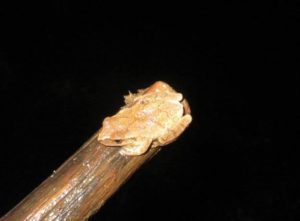
I photographed this spring peeper treefrog in the Manalapan Brook floodplain in Monroe, Middlesex County, in March. They are early spring callers. But I am pretty sure I heard the species calling this week at Farrington Lake on the boundary of North Brunswick, East Brunswick, and South Brunswick, all in Middlesex County – one of those aberrations of nature.
BLOOMING FLOWERS: Garden flowers continued blooming. In Kingston, on the South Brunswick, Middlesex County, side, for example, I saw a beautiful planting of zinnias along Route 27 in front of the Eno Terra restaurant.
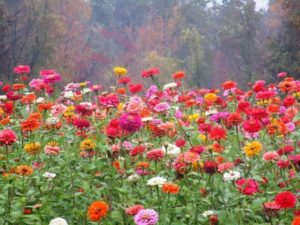
Here in Kingston on the South Brunswick, Middlesex County, side of Route 27, grows an ornamental planting of zinnias with the fall foliage colors in the background.
VOICE FROM AFIELD, CHRIS BEVINS: Chris Bevins checked in from Monroe, Middlesex County, where he works for the Utility Department: “I was working on a project this morning and the irrigation pond at the end of England Road on the field had a mated pair of freshwater otters eating fish and frolicking.” I hope to see them, because I have never seen an otter, “Lontra canadensis.”
MY GARDEN: My vegetable garden – between Helmetta and Jamesburg in South Middlesex County — took a licking because of heavy rain over the summer. Other than the colorful and pollinating-attracting zinnias, it was a bad year – basically only a bit of sweet corn to show for the work. But, then this week, I harvested some of my early spring plantings of Lake Valley “Rainbow Blend” carrots. Now, I will watch to see how my late-season planting of carrots does.
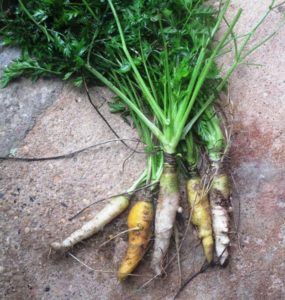
Planted April 8 as part of my early crop, these Lake Valley “Rainbow Blend” heirloom carrots were harvested Sunday, October 29.
VOICE FROM THE GARDEN, PAUL MIGUT: Paul Migut, now in his early 60s, who has been gardening since childhood, reported in from South River, Middlesex County: “November 2, a balmy 75f. Garden cleaned out and tilled up. A few eggplants picked and one grape tomato plant still hanging in there. While no match for Pon’s garden from days of old” – a reference to his Uncle Stanley “Pon” Ceslowski and his garden in Monroe, Middlesex County – “my 20 feet by 20 feet section still manages to provide vegetables for the two of us” – Paul and his wife, Karen – “and then some.”
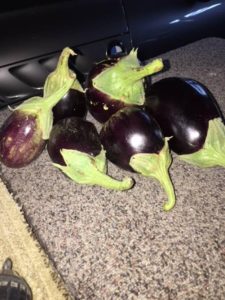
The “last of the eggplants,” according to Paul Migut, from his South River, Middlesex County, garden.
DRIVE-BY NATURALIST, VULTURES: During the nor’easter, I came across these vultures in the Monmouth Junction section of South Brunswick, Middlesex County.
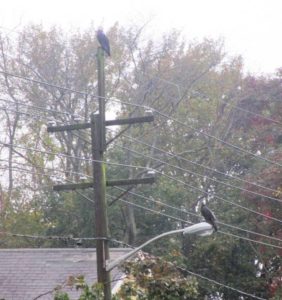
Vultures across the street from the Monmouth Junction Elementary School in South Brunswick, Middlesex County.
DRIVE-BY NATURALIST, HAZY SKY: On Thursday, November 2, I awoke to weather reports warning of fog. By the time I left the house around 8 a.m., though, there was no ground-level fog to speak of, but the sky had a haze. Sunshine fighting through that haze provided a beautiful view – one to photograph.
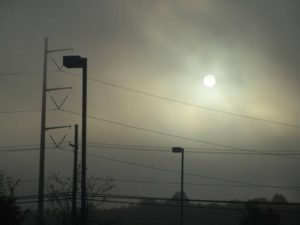
The sun breaks through the haze over the Jamesburg Park Conservation Area on the boundary of South Brunswick and East Brunswick, both in Middlesex County.
CLOUDS, NEW BRUNSWICK: Beautiful cloud views continue. This week, for example, at New Brunswick, Middlesex County – the Douglass-Cook campus of Rutgers University and along the Raritan River.
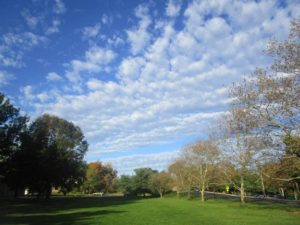
Clouds above the Douglass-Cook campus at Rutgers University in New Brunswick, Middlesex County.

Over the Raritan River from George Street in New Brunswick, Middlesex County.
RUTGERS UNIVERSITY SQUIRRELS: As I walk through the Rutgers University College Avenue and Douglass-Cook campuses in New Brunswick, Middlesex County, Mondays through Fridays, I find the squirrels, “Sciurus carolinensis,” entertaining and numerous. If I were a squirrel in New Brunswick, I probably would pick the garden-y campus, rather than the urban sectors.
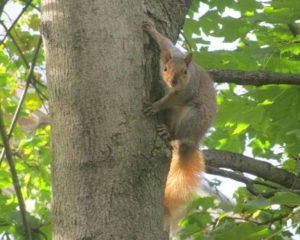
This squirrel has quite a bit of red tint.
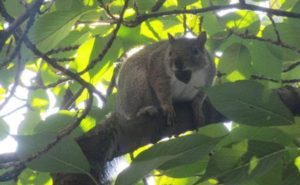
Acting as a squirrel with acorn in mouth.
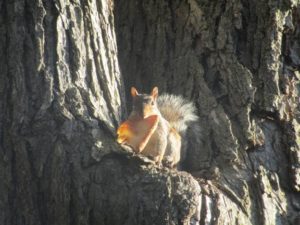
This squirrel was acting like a human, with some kind of bread in its mouth.
OCEAN TEMPERATURES: Atlantic Ocean temperatures on the New Jersey coast were about 60 degrees to 62 degrees over the November 4-5 weekend.
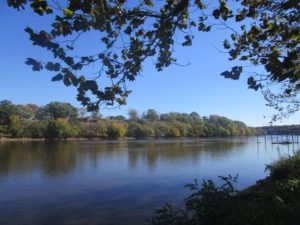
On the banks of the old Raritan River, looking downstream from New Brunswick, across the river to Highland Park, both in Middlesex County.
CHANGE THE CLOCKS: We switch from Daylight Savings Time to Standard Time November 5, Sunday, at 2 a.m., the clocks moving back to 1 a.m.
SUNRISE/SUNSET: For November 5, Sunday, to November 11, Saturday, the sun will rise about 6:35 a.m. set about 4:45 p.m. For November 12, Sunday, to November 18, Saturday, the sun will rise about 6:40 to 6:45 a.m. and set about 4:35 to 4:40 p.m.
WEATHER: The National Weather Service forecasting station for the area is at http://www.weather.gov/phi/.

Pictured is the Full Frost Moon on the November 3-4 overnight. The next full moon is the Long Night Moon on the December 2-3 overnight.
A PARTING NOTE, HAIKU: The Japanese poetry style of 5 syllables, 7 syllables, and, finally, 5 syllables:
Look into the woods –
The leaves are changing colors.
Yellow, orange, red.
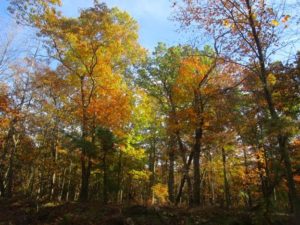
Leaves changing colors in the Pine Barrens around Helmetta, Middlesex County.
Joe Sapia, 60, is a lifelong resident of Monroe — in South Middlesex County, where his maternal family settled more than 100 years ago. He is a Pine Barrens naturalist and a gardener of organic vegetables and fruit, along with zinnias and roses. He draws inspiration on the Pine Barrens around Helmetta from his mother, Sophie Onda Sapia, who lived her whole life in these Pines, and his Polish-immigrant grandmother, Annie Poznanski Onda. He gardens the same backyard plot as did his Grandma Annie and Italian-American father, Joe Sr. Both are inspirations for his food gardening. Ma inspires his rose gardening. Joe’s work also is at @JosephSapia on Twitter.com, along with Facebook.com on the Jersey Midlands page.
Except as noted, article and photos by Joe Sapia
Note: The yard references are to my house in the section of Monroe between Helmetta and Jamesburg in South Middlesex County. My yard is in a Pine Barrens outlier on the Inner Coastal Plain, the soil is loamy, and my neighborhood is on the boundary of Gardening Zones 6b (cooler) and 7a (warmer). Notes and photographs are for the period covered, unless otherwise noted.
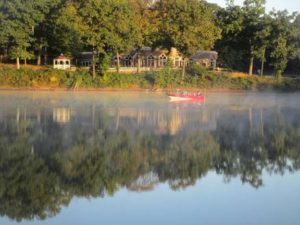
Morning on Farrington Lake, looking from East Brunswick to North Brunswick, both in Middlesex County, at the Hardenburg Lane bridge. Being on New Jersey’s Coastal Plain, where there are few, if any, natural bodies of water, Farrington Lake is created by the damming of Lawrence Brook between Davidson Mill Pond Park and Milltown.
FIRETOWERS: New Jersey’s fall wildfire season coincides with leaves falling and normally runs until about Thanksgiving and that time of year’s colder temperatures. But there could be a wildfire threat at any time if conditions are correct — and, now, we have had both falling leaves and dry conditions. So, the state Forest Fire Service is staffing its lookout towers. Visitors are welcome to go up in the towers when they are staffed – but, remember, you not only have to walk up the tower stairs, but you have to walk down. These Forest Fire Service towers are in the Jersey Midlands: Jamesburg/Middlesex County, Lakewood/Ocean County, Cedar Bridge/Ocean County, Medford/Burlington County, Lebanon/Burlington County, Apple Pie Hill/Burlington County, Batsto/Burlington County, and Bass River/Burlington County.
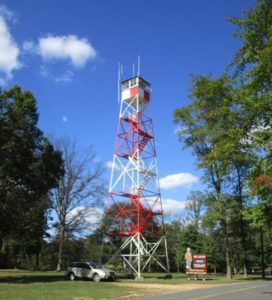
“Jamesburg Tower,” actually outside of Jamesburg in a Monroe Township section of Thompson Park, is about 65-feet-tall, sitting on high ground of about 150 feet above sea level over the Raritan River watershed.
GREAT HORNED OWL: Late at night, as I was at my desk, I thought I heard one of my favorite night sounds, the resonating hoot, hoot, hoot of a great horned owl, “Bubo virginianus.” I went outside and heard what I thought was a faint call of one, then nothing. The great horned is an early breeder, so the calling, signally both territory and looking for mates, should increase. More information, including audio of its calls, is at Cornell University’s All About Birds website, https://www.allaboutbirds.org/guide/Great_Horned_Owl/id.
BALD EAGLE, OCEAN COUNTY: Diane Larson, the home horticulturist and leader of the Master Gardeners program in Rutgers University’s Cooperative Extension Office/Monmouth County, sent in this photograph taken by her stepson, Danny Larson. It is a juvenile bald eagle, photographed on the afternoon of Thursday, October 5, on Beaver Dam Creek in Brick, Ocean County. Diane was leaning toward bald eagle, “Haliaeetus leucocephalus,” but raised a question if it could be a golden eagle, “Aquila chrysaetos.” Two New Jersey Audubon Society naturalists, Pete Bacinski (retired) and Scott Barnes (active) made the identification via this photograph. “It is a juvenile bald eagle,” Pete said. “The bill is too large for (a) golden.” “Yes, definitely a juvenile bald eagle,” Scott said. (Thank you, Danny, Diane, Pete, and Scott, for the team effort.)
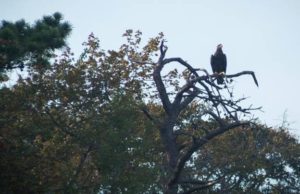
Danny Larson photographed this juvenile bald eagle on Beaver Dam Creek near his family’s house in Brick, Ocean County. (Photography copyright 2017 by Danny Larson.)
DRIVE-BY NATURALIST, DOUBLE-CRESTED CORMORANT: As I drive through the Pigeon Swamp area of South Brunswick, Middlesex County, I pass a warehouse area. There, I often see a double-crested cormorant, “Phalacrocorax auritus,” at a retention pond.

A double-crested cormorant in a retention pond in South Brunswick, Middlesex County.
STEAMING FARRINGTON LAKE: When water temperature is much warmer than air temperature, bodies of water look like steaming soup. I caught this view of Farrington Lake on a cool morning. A few winters back, when we experienced real cold temperatures, this phenomenon was seen at the Atlantic Ocean – a really cool view.
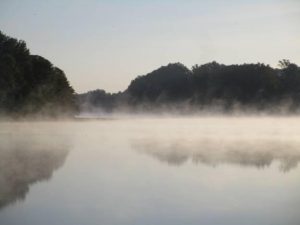
A steamy Farrington Lake, looking from East Brunswick to North Brunswick.
FALL ON THE FARMS: It is fall, so farms are displaying pumpkins and chrysanthemums. Field corn, or feed corn, awaits harvesting.
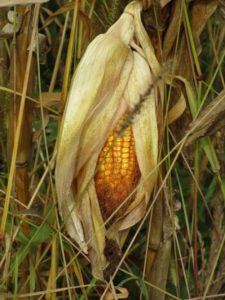
Field corn awaits harvesting in South Brunswick, Middlesex County
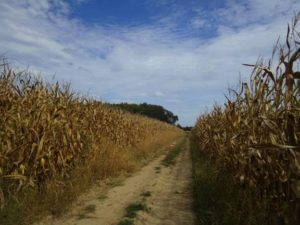
Acres of field corn await harvesting in South Brunswick
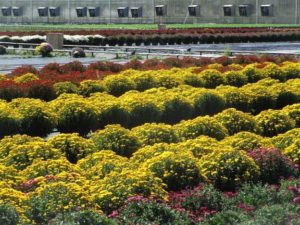
Chrysanthemums at Davino’s Nursery in East Windsor, Mercer County.
CLOUDS, NO. 1: One of the week’s beautiful clouds and sky view was from the East Windsor Community Garden in Mercer County.
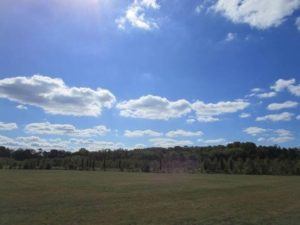
Beautiful clouds and sky view at East Windsor Community Garden in Mercer County.
CLOUDS, NO. 2: Another view of beautiful sky with clouds was from my backyard in Monroe, Middlesex County.

A clouds-in-the-sky view from my backyard in Monroe, Middlesex County.

Another clouds-in-the-sky view from my backyard.
OCEAN TEMPERATURES: Atlantic Ocean temperatures on the New Jersey coast were about 69 degrees to 71 degrees during the weekend of October 7 and 8.
SUNRISE/SUNSET: For October 8, Sunday, to October 14, Saturday, the sun will rise about 7:05 a.m. and set about 6:25 p.m. For October 15, Sunday, to October 21, Saturday, the sun will rise from about 7:10 to 7:15 a.m. and set about 6:10 to 6:15 p.m.
THE NIGHT SKY: The next full moon is the Frost Moon on the November 3-4 overnight.
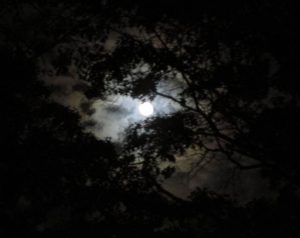
The moon over Manalapan Brook and its floodplain in Monroe, Middlesex County. This moon is waning after October 5’s Full Harvest Moon.
WEATHER: The National Weather Service forecasting station for the area is at http://www.weather.gov/phi/.

A view from Jamesburg Tower, looking south toward Monroe Township High School, from the spring of 2014.
Joe Sapia, 60, is a lifelong Monroe resident. He is a Pine Barrens naturalist and an organic vegetable-fruit gardener. He gardens the same backyard plot as did his Italian-American father, Joe Sr., and his Polish-immigrant, maternal grandmother, Annie Poznanski Onda. Both are inspirations for his food gardening. Joe is active with the Rutgers University Master Gardeners/Middlesex County program. He draws inspiration on the Pine Barrens around Helmetta from his mother, Sophie Onda Sapia, who lived her whole life in these Pines, and his Grandma Annie. Joe’s work also is at @JosephSapia on Twitter.com, along with Facebook.com on the Jersey Midlands page. Copyright 2017 by Joseph Sapia
Article and photos by Joe Mish
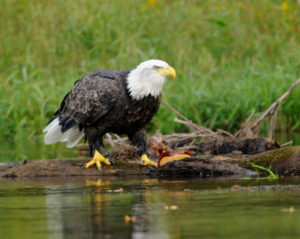
The food chain is not a one way street, as a turtle whose kin may feed on baby ducks, gets picked on by a bald eagle
It is unthinkable to imagine a restaurant where the diners are often listed as menu items. Though when seated at nature’s dinner table, the catch of the day takes on a whole new meaning as predators and prey freely alternate position. The dietary choices are also a surprise as the variety of delectable meals is often at odds with expectations.
Sorting through my library of photos, I was perplexed trying to categorize some images showing two species in close contact. Obviously notable was the reversal of who was eating who.
The first image which prompted these thoughts was captured as I launched my canoe. Here was a very young painted water snake, brilliant colored markings, with a fish sticking out its mouth. Comparing the size of the snake to the fish, I wondered if the snake ‘bit off more than he could chew’, as they say. The fish was wider than the snake and it didn’t look like much progress was being made in the attempt to swallow it. I couldn’t identify the species of fish but thought it a moment of karma as small mouth bass which inhabit the river are well known to forage on anything that swims or crawls in the waters of the south branch. A small snake would hardly be ignored by a hungry bass.
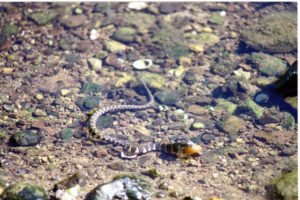
Another image shows a larger painted water snake suspended on o vertical river bank holding onto the tail of a gold colored catfish. As the snake was in an awkward position and didn’t want to go into the water, it was a standoff with the advantage going to the snake. The fish would struggle and then lay still. Eventually the fish broke free. I then remembered a series of images documenting another struggle where a snapping turtle grabbed a painted water snake by the tail. As I paddled along, I saw a water snake swimming across the river and as it neared the opposite bank it suddenly reared up and began to thrash about. Mystery solved as a snapping turtle soon surfaced holding on tight, as the snake now alternated struggling and lying still. As I drifted closer, the turtle was intimidated into releasing its grip and the snake swam off.
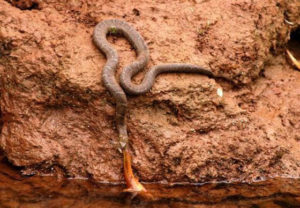
A painted water snake has a catfish by the tail. The snake is barely holding on to the vertical bank , using a tuft of grass to secure its precarious position. the catfish would struggle mighily and then rest. After several tries the catfish appeared dead and lay still for quite some time. Suddenly the catfish came to life and broke free. Again, the scene was captured from a canoe.
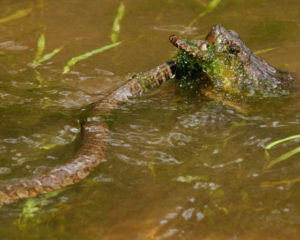
A painted water snakes has the tables turned on it as a snapping turtle reached up to grab the snake swimming across the river.
Turtles are not immune from the proverbial soup bowl as they are prey to many birds and animals that share the same habitat. Even large water snakes will easily swallow a turtle hatchling seeking cover in the water, as will great blue herons, mink, fox, skunk, raccoon and birds of prey.
In a twist of fate, the turtle that killed baby ducks in a farm pond yesterday could very well be on a larger bird’s menu today.
Such was the case when I spotted a bald eagle standing on a log near shore, intently pulling and tearing away at what was probably a deer carcass or white sucker. The eagle would occasionally look up and certainly it saw me from two hundred yards away, apparently not at all intimidated. As I closed the distance, a bright yellow object was clearly visible and the focus of the eagle’s rapt attention. I began to take photos, drifting ever closer and as I started to pass the eagle, it flew off. It was then I realized the eagle was dining on a painted turtle!
Across the land where rivers flow, the lines between predator and prey begin to blur. Don’t be surprised when a squirrel is seen carry a baby crow or a muskrat is swimming underwater holding a baby blue jay or a blue jay is flying off with a dead vole. If you can’t imagine it, it is happening somewhere along our wild rivers.
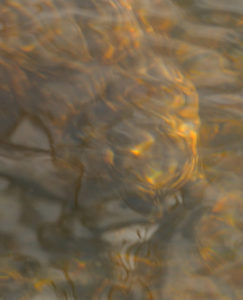
Muskrat with a bluejay swims into its den’s underwater entrance. Mystery for sure.
Author Joe Mish has been running wild in New Jersey since childhood when he found ways to escape his mother’s watchful eyes. He continues to trek the swamps, rivers and thickets seeking to share, with the residents and visitors, all of the state’s natural beauty hidden within full view. To read more of his writing and view more of his gorgeous photographs visit Winter Bear Rising, his wordpress blog. Joe’s series “Nature on the Raritan, Hidden in Plain View” runs monthly as part of the LRWP “Voices of the Watershed” series. Writing and photos used with permission from the author.
Article and photos by Joe Sapia
Note: The yard references are to my house in the section of Monroe between Helmetta and Jamesburg in South Middlesex County. My yard is in a Pine Barrens outlier on the Inner Coastal Plain, the soil is loamy, and my neighborhood is on the boundary of Gardening Zones 6b (cooler) and 7a (warmer). Notes and photographs are for the period covered, unless otherwise noted.

A bit of a strange scene in my backyard: forsythia blooming among the fall foliage changing of colors.
SPRING IN THE FALL: Years ago, I recall seeing sheep laurel, “Kalmia angustifolia,” a spring bloomer, flowering in the fall in the Pine Barrens around Helmetta. Twice this week, I noticed a bird or birds singing away, seemingly a springtime song; And a red-bellied woodpecker, “Melanerpes carolinus,” drummed against my house. Also, this week, I noticed another spring bloomer in flower – forsythia. It flowered in my backyard. I normally see forsythia blooming for the first time of the season in early March to mid-April. What does it all mean? I just think the fall conditions are replicating spring conditions, especially the summerlike temperatures.
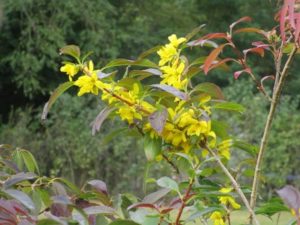
The backyard forsythia in bloom.
THE PINE BARRENS “FALL FOLIAGE” PEAK: The Pine Barrens’s name is a misnomer, neither a place of all pines nor barren lands. And it is a great place to see the changing colors of the fall foliage – the deciduous vegetation changes, with blueberry bushes turning flaming red, and contrasts with the greens of pines, cedars, and laurels. Normally, I look for the fall foliage color peak in the Pine Barrens on October 13 in the wetlands and October 20 in the uplands. This year, that schedule is running behind. The woods around Helmetta are still quite green. (“Fall foliage” is a misnomer, too. In the Pine Barrens around Helmetta, one can observe the changing colors beginning in about mid- to late July.)
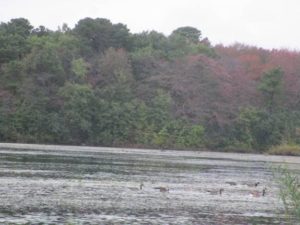
The colors are changing at Helmetta Pond October 13, Friday, but not yet peaking
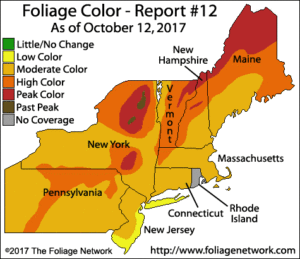
An October 12, Thursday, map from the Fall Foliage Network.
DRIVE-BY NATURALIST, PHEASANT: I just happened to be reading about ring-necked pheasants, “Phasianus colchicus,” the other day. Then, I saw one between the Applegarth and Wyckoff Mills section of Monroe, Middlesex County, the first time I recall seeing one afield in maybe 20 or 25 years. These are non-native – introduced to America from Asia in the 1880s, according to Cornell University’s All About Birds website, allaboutbirds.org. Now, they are naturalized in the United States. This one could have been a naturalized bird or one released for hunting.
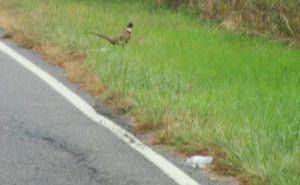
This is a rather blurry photograph, because I came across this ring-necked pheasant unexpectedly while I was driving and had to quickly crank off a photograph before it fled. I am using this photo because it shows a full view of the bird. Also, I did not crop out the roadside litter, to illustrate how wildlife competes with human carelessness.
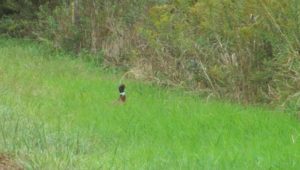
Notice the white, forming the ring around its neck.
CLOUDS: This week’s spectacular cloud scene was in Middlesex County, at North Brunswick, looking toward Milltown. I stopped at the McDonald’s restaurant for breakfast, looked at the sky, and there they were.
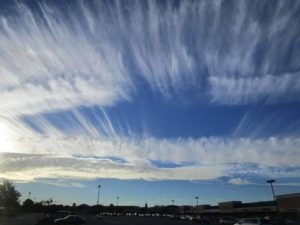
Clouds over North Brunswick, Middlesex County.
VOICES FROM (FAR) AFIELD, JUDY AUER SHAW: Judy Auer Shaw, author of “The Raritan River, Our Landscape, Our Legacy,” checked in from Ohio, reminded by a suggestion in a previous “Garden and Afield” to wear blaze orange in the woods in hunting areas: “I have a story from my teaching years in Michigan. I organized a nature hike for my kids (7th graders) and we all wore browns, grays and greens. As we approached the hiking trail, we were behind a carload of guys wearing orange. It finally dawned on me that we were going out on the first day of hunting season — in complete camouflage. Yikes! Needless to say, we were fine, but I was one worried den mother that day!”

Judy Auer Shaw’s 2014 book.
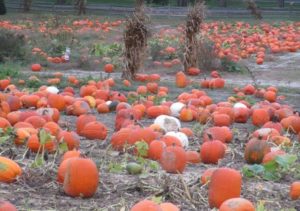
The pumpkin patch at Giamarese Farm on Fresh Ponds Road, East Brunswick, Middlesex County
YARD AND GARDEN: I planted five “false cypress,” or Crippsii,” I picked up at Krygier’s Nursery in South Brunswick, Middlesex County. The Knock Out roses and zinnias continue blooming – the zinnias being visited by such butterflies as the painted lady, “Vanessa virginiensis,” and cabbage white, “Pieris rapae.” Despite blooming, the zinnias are losing their luster, covered with powdery mildew, “Golovinomyces cichoracearum,” and a leaf spot disease. I also found my first raspberry on some bushes planted earlier this year.
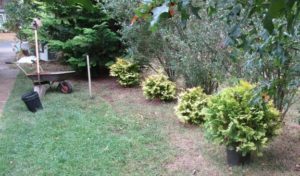
Five “false cypress,” or Crippsii, have been added to my yard.
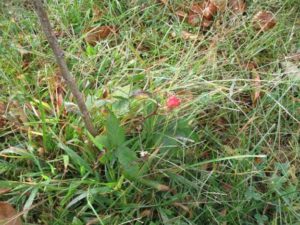
A raspberry fruiting in my backyard garden.
FARMING PERILS IN THE MIDLANDS: I was visiting Krygier’s Nursery, owned by husband and wife Jimmy Krygier, in South Brunswick, Middlesex County, and two perils were obvious – encroaching development and damage caused by browsing deer, “Odocoileus virginianus.” The nursery, a Krygier family business for three generations of about 100 years, is on Route 535, also known as Cranbury-South River Road, Cranbury Road, and South River Road. What was adjoining cornfield up to months ago is now a warehouse property, for example. And one only has to see how the deer have shaped the arbor vitae trees through their browsing. (Krygier’s Nursery is at the corner of Route 535 and Dunham’s Corner Road, South Brunswick, near the Middlesex County Fair Grounds).
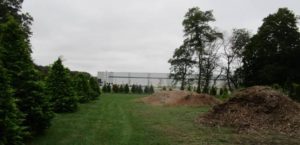
Development encroaches Krygier’s Nursery in South Brunswick, Middlesex County.
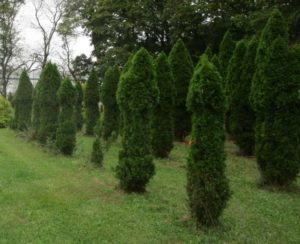
Notice the odd shape to the arbor vitae. It is caused by deer nibbling on the trees.
DEER DOCUMENTARY: “The Deer Stand” is a documentary about deer over-population in the Jersey Midlands. See the movie at https://vimeo.com/233572156.

In fall of 2016, Anna Luiten, an ecologist with the Monmouth County Park System, stands in a Thompson Park forest area over-browsed by deer. The fenced area contains a lush understory, because it is protected from deer.
SNOWBIRDS: Anybody seeing dark-eyed juncos, or “snowbirds,” yet? The birds, “Junco hyemalis,” come down to our area from as far away as Canada during the cold-weather months. I normally begin seeing them in my yard around Halloween. Their color pattern of slate gray on their backs and white on their fronts suggests, “Dark skies above, snow below.”
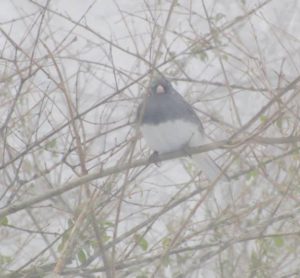
A “snowbird” in the snow in my yard in early 2017.
OCEAN TEMPERATURES: Atlantic Ocean temperatures on the New Jersey coast were about 67 degrees to 69 degrees during the October 14-15 weekend.
SUNRISE/SUNSET: For October 15, Sunday, to October 21, Saturday, the sun will rise from about 7:10 to 7:15 a.m. and set about 6:10 to 6:15 p.m. For October 22, Sunday, to October 28, Saturday, the sun will rise about 7:20 a.m. and set about 6 a.m. to 6:05 a.m. We switch to Daylight Savings Time November 5, Sunday, at 2 a.m., the clocks moving back to 1 a.m.
THE NIGHT SKY: The next full moon is the Frost Moon on the November 3-4 overnight.
WEATHER: The National Weather Service forecasting station for the area is at http://www.weather.gov/phi/.
UPCOMING: 2017, October 28, Saturday, 1 p.m. book signing and 2 p.m. lecture with Marta McDowell, author of “Beatrix Potter’s Gardening Life,” at Jamesburg Presbyterian Church, 175 Gatzmer Ave, Jamesburg. $30 at the door. More information is available from the Earth Center Conservancy (of Middlesex County), www.ecc-nj.com. Beatrix Potter, born in 1866 and died in 1943, was a children’s writer and illustrator. She wrote and illustrated “The Tale of Peter Rabbit,” 1901.

Author Marta McDowell will sign books and speak in Jamesburg, Middlesex County, October 28, Saturday.

Gray squirrels, “Sciurus carolinensis,” appear to be active, burying acorns, preparing for winter. This one was at Rutgers University’s College Avenue Campus in New Brunswick, Middlesex County.
Joe Sapia, 60, is a lifelong Monroe resident. He is a Pine Barrens naturalist and an organic vegetable-fruit gardener. He gardens the same backyard plot as did his Italian-American father, Joe Sr., and his Polish-immigrant, maternal grandmother, Annie Poznanski Onda. Both are inspirations for his food gardening. He draws inspiration on the Pine Barrens around Helmetta from his mother, Sophie Onda Sapia, who lived her whole life in these Pines, and his Grandma Annie. Joe’s work also is at @JosephSapia on Twitter.com, along with Facebook.com on the Jersey Midlands page.
Article and photos by Joe Mish
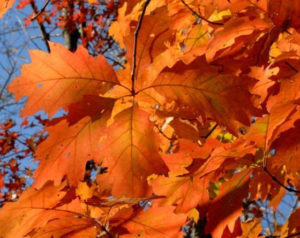
Black oak leaves are ablaze in the most incredible orange color, which makes you wonder how the black oak got its name.
A robe of many colors is October’s alone to wear. It is a coarse cloth, woven with silken threads of yellow and orange, melting into the extreme end of the red spectrum. Set against a clear blue sky, the colors radiate with brilliance. While the sun is otherwise occupied behind gathering clouds, the colors are no less extraordinary, as they hold their sharp contrast, presenting with a soft matte finish.
As the robe is placed upon the earth’s shoulders, the colors slowly flow downward in an infinitely slow progression, best seen from high above the earth. With that image in mind, it is easy to visualize autumn as a living creature leaving a momentary trail of color across the breadth of the tilting earth.
An alternative to a live, time lapsed satellite image of autumn’s gradual crawl across the latitudes, is best seen from a lofty vantage point with expansive views. Though the view is static, the full range of colors is on display. The cloth of the colorful cloak lies tight against the contour of the wooded mountains, each undulating feature of the landscape accentuated by shade and light. On a typical sunlit October day, herds of white billowy clouds drift across the blue sky followed on the ground by their shadows trying to keep up. As the lagging shadows flow across the colorful mountainsides, the tints change for a brief moment to provide a sense of movement to an otherwise still image. The scene is more dramatic if you can imagine the passing shadows being that of the artist’s hand working as you watch.
Retreating from distant views to stand within the October woodlands, individual trees and stands of trees become the focus. Each species resplendent in their own genetically defined color, modified to some degree by soil conditions, specifically, available nutrients and moisture. Instead of looking at a mass of treetops where smudges of varied colors blend together, we now see the pixels that make up the distant image.
Comparing trees of the same species, we can see the individual variation of color. Many trees with yellow leaves such as hickories, Norway maples, cherry and tulip poplar trees are very consistent in color. Oaks, sweetgum and some maples, whose leaves have a red component, show the most diversity.
The most glorious displays of fall color are where we find them, scattered among the local landscape. Each, an emissary heralding the arrival of autumn; apart from the mass of color sweeping across the land.
We all have a perennial favorite we watch on a daily basis to gauge the progress of autumn color.
A lone white oak in the middle of a field or a native red maple pressing against the chain link fence in the backyard, as seen from the bathroom window, serve as daily alerts.
Among the many autumn images accumulated in my experience, the one that keeps appearing is an old abandoned farm road lined with Norway maples, all the same size. The tree tops form a tight canopy over the road, keeping it clear of weeds and paving it with a golden carpet of fallen leaves. The length of the yellow paved road has a hint of a vanishing point that beckons a traveler to follow deeper into the fire of autumn color.
Author Joe Mish has been running wild in New Jersey since childhood when he found ways to escape his mother’s watchful eyes. He continues to trek the swamps, rivers and thickets seeking to share, with the residents and visitors, all of the state’s natural beauty hidden within full view. To read more of his writing and view more of his gorgeous photographs visit Winter Bear Rising, his wordpress blog. Joe’s series “Nature on the Raritan, Hidden in Plain View” runs monthly as part of the LRWP “Voices of the Watershed” series. Writing and photos used with permission from the author.
Article and photos by Joe Sapia
Note: The yard references are to my house in the section of Monroe between Helmetta and Jamesburg in South Middlesex County. My yard is in a Pine Barrens outlier on the Inner Coastal Plain, the soil is loamy, and my neighborhood is on the boundary of Gardening Zones 6b (cooler) and 7a (warmer). Notes and photographs are for the period covered, unless otherwise noted.

Dawn on the Delaware River, looking downstream from Hamilton, Mercer County, to the other side of the river and Bucks County, Pennsylvania.
ABBOTT MARSHLANDS: The Abbott Marshlands are about 3,000 acres, about 1,300 wetlands and 1,700 uplands, along the Delaware River on the boundary of Burlington and Mercer counties in the Bordentown-Trenton area. An interesting point of the marsh is that it is both freshwater and tidal. While Delaware River saltwater going inland ends between the Delaware Memorial Bridge and Philadelphia, the tidal effect continues for miles upstream to the Marshlands. The Marshlands also are known as the Trenton Marsh and the Hamilton Marsh. More information is at http://abbottmarshlands.org/.
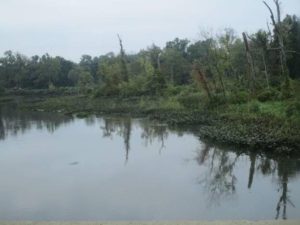
The Abbott Marshlands at Hamilton, Mercer County.
MONARCH BUTTERFLIES: Watch for monarch butterflies, “Danaus plexippus,” on their southern migration, to either Florida or, more likely, Mexico. This “super generation” are the great-grandchildren of last fall’s migrators and will make the complete migration. However, next year, they will begin northward, but will only make it so far, requiring three breedings to complete the journey north. Then, those great-grandchildren will become a “super generation,” making the entire journey south.
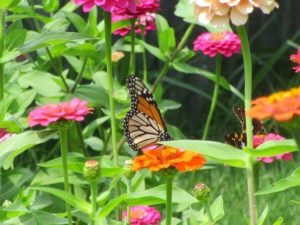
A monarch butterfly in my garden in August.
DRIVE-BY NATURALIST, BLACK VULTURES: I was driving to Princeton, Mercer County, to meet the lovely Pamela for breakfast and came across quite a scene on Route 27 in South Brunswick, Middlesex County – dozens of black vultures, “Coragyps atratus,” feeding on a dead deer. (As I mentioned last month, I do not recall seeing a black vulture locally until probably the 1990s. They are a southern species that has moved north.) Remember, nature is all around us, just keep an eye out for it.
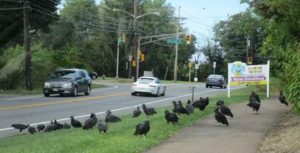
Black vultures on Route 27 in South Brunswick, Middlesex County.
DRIVE-BY NATURALIST, CHESTNUT TREES: As I was driving through the Pine Barrens around Helmetta, I noticed a Middlesex County Parks and Recreation pickup at the Jamesburg Park Conservation Area. I had to talk to naturalist Eric Gehring about a volunteer project, so I turned around and pulled over. Eric was on a mission with Les Nichols of the American Chestnut Foundation, looking for chestnut trees, “Castanea dentata,” in the Conservation Area. Since around 1900, the American chestnut has been plagued by a non-native and extremely invasive and potent fungal blight, “Cryphonectria parasitica,” – estimated to have crippled up to 4 billion chestnuts initially. American Chestnut blight affects the tree upward from where it infects it. The tree, then, is able to sprout again from roots, only to have those shoots, except for rare cases, infected. The Foundation seeks good specimens, hoping to create resistance in future chestnuts. Eric asked if I knew of chestnuts growing in these woods. Yes, at Swing Hill (which Eric already knew about) and at Big Tree. Into the woods, we headed – on my part unexpectedly, but I would rather walk the woods my family has walked for more than 100 years than do chores around the house – looking for specimens that may produce sought-after seeds in the future.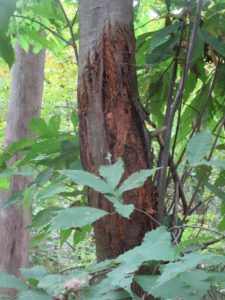
An American chestnut, in the Pine Barrens around Helmetta, infected with the fungal blight.
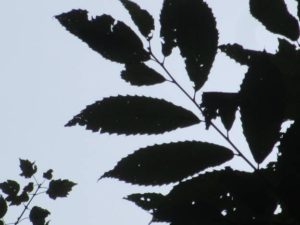
American chestnut leaves in silhouette – serrated with a surf wave-like pattern.
STINK BUGS: I had noticed one or two brown marmorated stink bugs, “Halyomorpha halys,” outside the house. This is an Asian species, apparently introduced accidentally in the Allentown, Pennsylvania, area in 1996. This week, I found one in the house on a blind in my living room — perhaps just the beginning of an infiltration for their overwintering. As a Rutgers University fact sheet says, “They enter houses through cracks in windows and the foundation and may be seen in large numbers during September and October.” If you go after one and, say, crush it, it will release an earthy odor. So, it is a nuisance, not a damaging bug to the house. However, it is a serious threat to crops. More information is available at https://njaes.rutgers.edu/stinkbug/. (As for crickets in the house, my $45,000 cricket deterrent project – that is the remodeling with the side benefit of keeping crickets out of the house – seems to be working. So far, only 8 crickets in the cellar and 2 in the living section of the house. A cacophony of crickets is beautiful music. A single cricket rubbing its legs in the wee hours like the fingernail scratching of a blackboard. While cleaning the garage, I may have discovered their last main intrusion route into the living section – through a crack/opening between garage floor and foundation.)
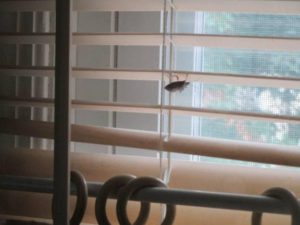
marmorated stink bug on a living room blind.
BIRD FEEDING: This is the first summer in years I have not gone all out feeding the birds in my yard. I miss watching them, but I saved quite a bit of money (because I use only sunflower hearts or kernels) and tried something new, letting the birds eat insects, serving as a natural pesticide. But the bird-feeder is back up and the birds are slowly discovering it. I am looking forward to beginning my day watching birds feed.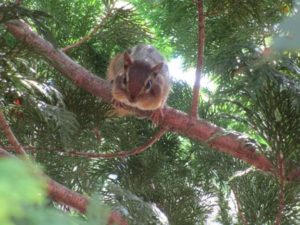
A chipmunk, “Tamias striatus,” in the yard.
FERRIS FARMS: Now that I am feeding the birds in my yard again, I stopped by my regular bird food supplier, Ferris Farms in East Brunswick, Middlesex County. I recall visiting Ferris as a youngster with my family. Mike Rutkowski and Tony Riccobono have always been friendly and helpful when I have asked gardening questions. See http://www.ferrisfarms.org/.
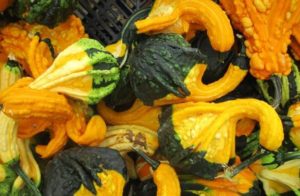
Gourds at Ferris Farms in East Brunswick, Middlesex County.
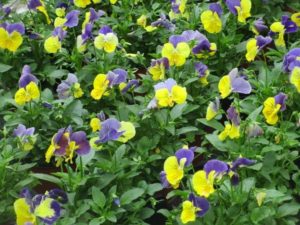
Pansies at Ferris Farms.
KITCHEN TABLE: The flower display on my kitchen table gets better and better. One, the Knock Out roses continued flowering. Two, the zinnias also continued blooming. Three, I learned the display looked better with the more zinnias that I used. Lastly, the gourds were the same as before but they seemed to be yellowing in color, making them more autumn-like. Of course, the antique, porcelain-top table adds to the country-ness of the display. On the down side, this rose bloom seems on its way out. (I have something up my sleeve, though: Grandma Annie Onda’s old kitchen table, with porcelain top and more ornate build, stands ready in my cellar to be moved upstairs to the kitchen.)
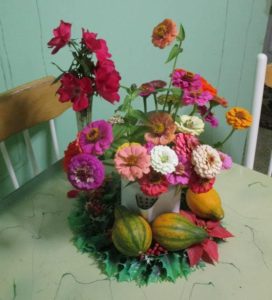
The kitchen table flower display.
ZINNIAS IN THE GARDEN: This week, my zinnias were distributed to the Helmetta Post Office, the lovely Pamela’s, and Jamesburg Dental Care (where I had my first dental appointment 55 years ago under Dr. Lew Goldstein). Butterflies continue to visit my zinnia patch.
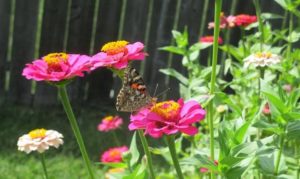
A painted lady, “Vanessa cardui,” in the zinnia patch.
HURRICANE JOSE, THE GOOD: Jose’s effects brought out sightseers to look at the roughness of the ocean. And I saw parasailing surfers taking advantage of the winds at the Atlantic Ocean at Sea Bright, Monmouth County.

A parasailing surfer in the Atlantic Ocean at Sea Bright, Monmouth County.
WEEDS IN THE YARD: When I see some kind of vegetation popping up in the yard, I let it grow to observe it. So, year after year, pokeweed, “Phytolacca americana,” pops up, one plant along my driveway, another in my garden. Here is an interesting article on this complicated plant, http://nadiasyard.com/our-native-plants/american-pokeweed/.
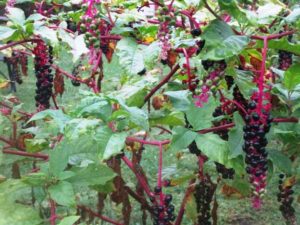
Pokeweed in the garden.
MONMOUTH CONSERVATION FOUNDATION: A shout-out to the Monmouth Conservation Foundation, a not-for-profit land preservation group in Monmouth County, as it celebrates its 40th anniversary. Over the 40 years, it has helped save more than 22,000 acres of open space. (The Foundation recently contracted me to write two articles – one on the group’s origin and another on Monmouth County wildlife — for one of its upcoming publications.)
OCEAN TEMPERATURES: Atlantic Ocean temperatures on the New Jersey coast were about 69 degrees to 74 degrees on the weekend of September 23-24.
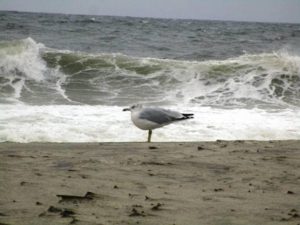
A gull at the Atlantic Ocean beach at Sea Bright, Monmouth County.
SUNRISE/SUNSET: For September 24, Sunday, to September 30, Saturday, the sun will rise about 6:50 a.m. and set about 6:45 p.m. For October 1, Sunday, to October 7, Saturday, the sun will rise about 6:55 to 7 a.m. and set about 6:30 to 6:40 p.m.
THE NIGHT SKY: The next full moon is the Full Harvest Moon October 5, Thursday.
WEATHER: The National Weather Service forecasting station for the area is at http://www.weather.gov/phi/.
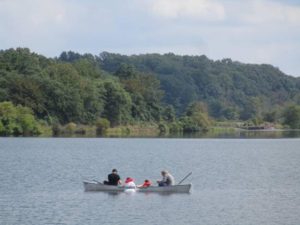
“Jamesburg Lake,” or more properly “Lake Manalapan,” on the boundary of Monroe and Jamesburg, Middlesex County, is about 35 to 40 acres. On the Outer and Inner Coastal Plains, there are few, if any, natural bodies of water. So, Jamesburg Lake on the Inner Coastal Plain is formed by the damming of Manalapan Brook.
Joe Sapia, 60, is a lifelong Monroe resident. He is a Pine Barrens naturalist and an organic vegetable-fruit gardener. He gardens the same backyard plot as did his Italian-American father, Joe Sr., and his Polish-immigrant, maternal grandmother, Annie Poznanski Onda. Both are inspirations for his food gardening. Joe is active with the Rutgers University Master Gardeners/Middlesex County program. He draws inspiration on the Pine Barrens around Helmetta from his mother, Sophie Onda Sapia, who lived her whole life in these Pines, and his Grandma Annie. Joe’s work also is at @JosephSapia on Twitter.com, along with Facebook.com on the Jersey Midlands page.
Article and photos by Joe Sapia
Note: The yard references are to my house in the section of Monroe between Helmetta and Jamesburg in South Middlesex County. My yard is in a Pine Barrens outlier on the Inner Coastal Plain, the soil is loamy, and my neighborhood is on the boundary of Gardening Zones 6b (cooler) and 7a (warmer). Notes and photographs are for the period covered, unless otherwise noted.
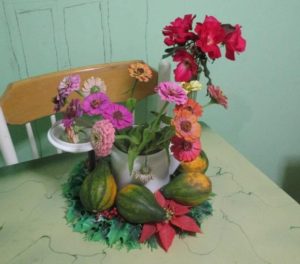
My kitchen table display gets better and better: Gourds, which mysteriously appeared in the garden, are added to the display of zinnias and Knock Out roses on the antique porcelain-top table.
BIG SKY COUNTRY, EMLEY’S HILL: I was driving through one of my favorite places in the Midlands, rural Western Monmouth County. I stopped at Upper Freehold’s Emley’s Hill, part of the cuesta geological formation that divides the Outer and Inner Coastal Plains. Generally, east of this hilly formation drains directly to the Atlantic Ocean, while west of the cuesta drains to the Raritan River. Emley Hill, though, is on a spur of the cuesta dividing the drainages of the Raritan River and the Delaware River. Because it is a hilly rural area at about 140 feet above sea level with lower surrounding farmland, there are beautiful big-sky views. Emley’s Hill is at the intersection of Emley’s Hill Road and Burlington Path Road.
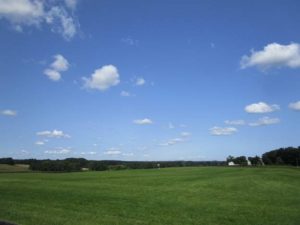
Looking east from Emley’s Hill in Upper Freehold, Monmouth County.
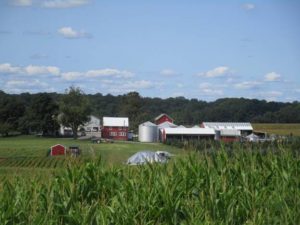
Looking north from Emley’s Hill at the Bullock Farms, http://www.bullockfarms.com/.
WILD OUTDOOR EXPO: The New Jersey Wild Outdoor Expo is an annual event, held at the Colliers Mills Wildlife Management Area in Ocean County. It includes information on environmental issues and parks, hunting, fishing, trapping, other recreational use of the outdoors, and so on.
This year’s expo, held on Saturday and Sunday, September 9 and 10, was sponsored by the state Department of Environmental Protection’s Division of Fish and Wildlife, Division of Parks and Forestry, and Forestry Services, along with the Conserve Wildlife Foundation of New Jersey.
Colliers Mills WMA is the almost 13,000 acres of open space — Pine Barrens forest, fields, waterways, and bodies of water — behind the Six Flags/Great Adventure amusement area. Outside of New Jersey, WMAs are referred to as “game lands.” In New Jersey, WMAs are shared by hunters and other recreational outdoors people.
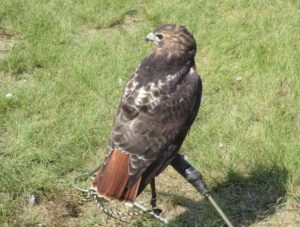
Red-tailed hawk, “Buteo jamaicensis,” on display at the Expo. Note the reddish tail giving the hawk its name. Red tails are commonly seen, soaring above, or commonly heard, calling in a wheezy-sound way.
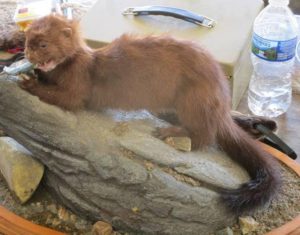
A mounted mink, “Mustela vison.” They are around, but the only two I have seen were both roadkills in recent years in the Pine Barrens around Helmetta.
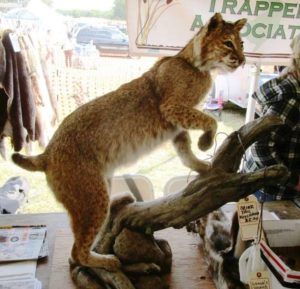
A mounted bobcat, “Lynx rufus.” I describe them as having a dog-like body with a cat’s head. I would love to see one in the wild. The state lists the bobcat as “endangered,” or in immediate peril of surviving.
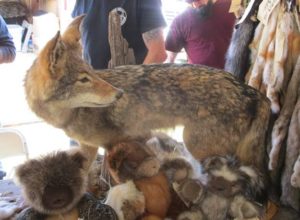
A mounted coyote, “Canis latrans.” Note the dog-like body, but pointy fox-like nose and ears. From 2014 to 2016, I worked an overnight shift near the Metropark train station in Woodbridge, Middlesex County, and I would occasionally see a coyote. One night, an ambulance was on the other side of the woods, yipping its siren. The coyotes started up, yipping away. Smart animals – I once read a suggestion if coyotes had opposing toes, they probably would run the world.
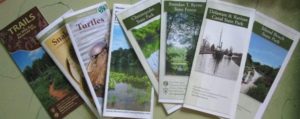
Brochures from the Expo.
FALLING ACORNS: I was driving one of the paved roads through the Jamesburg Park Conservation Area in the Pine Barrens around Helmetta and came across outdoorsman Art Utter, who lives nearby in Spotswood. Art was gathering acorns to use as hunting bait around his deerstand. While we were talking, I was listening to and dodging falling acorns. Earlier, Art got conked on the head by one and it drew blood. These things looked massive. Some might say these acorns suggest a severe winter ahead, with the acorns providing animals with food. I do not think it is a good predictor of anything. The only thing I got out of it was that it seemed as though acorns were falling steadily and they were big.
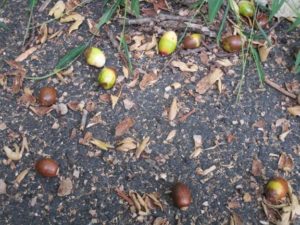
Acorns litter a road in the Jamesburg Park Conservation Area in the Pine Barrens around Helmetta.
IN THE GARDEN: I got tired of looking at the tangle of cucumber and cantaloupe plants that did not produce one usable item this year. So, I mowed them down, along with the tomatillos and gourds, both of which I did not plant. So, now, I look forward to fall lettuce, which is growing nicely, and carrots.
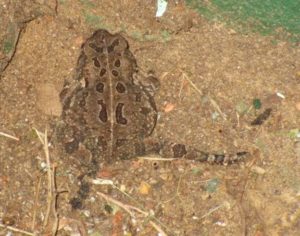
I came across this toad, genus “Anaxyrus,” while cutting the lawn.
THE FLOWERING YARD: The zinnias and Knock Out roses continue to bloom, although the zinnias may have slowed down – perhaps because of powdery mildew and leaf spot. But the Knock Outs seem to be flourishing.
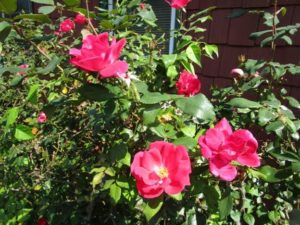
Knock Out roses continue to bloom nicely – even flourishing.
OUT-OF-SEASON FLOWERING: Occasionally, plants bloom out of season. In the past, I remember seeing sheep laurel, “Kalmia angustifolia,” blooming in the fall in the Pine Barrens around Helmetta, when its normal bloom is May and June. Maybe an out-of-season bloom was caused by temperatures and sunlight replicating normal bloom times. Whatever the reason, the flowering quince bush in my yard was actually flowering. Normal flowering would be in the spring.
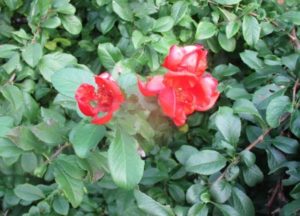
Flowering quince blooming out of season.
BIZARRE EXPERIENCE IN THE YARD: The flowering quince was unusual, but not bizarre. The bizarre experience happened a day earlier, when I was cutting the front yard grass. First, I notice a rabbit, “Sylvilagus floridanus,” watching me from a few feet away on the other side of the hedges. As I have mentioned, if I go about my own business, the rabbits and butterflies allow me to get close. As I was cutting the grass along the street’s edge, I noticed something embedded in the ground where I had just mowed – a 20-gauge, loaded shotgun shell! If I cut that open when I was mowing, I could have sprayed hundreds of pellets. Fortunately, it was intact, but bent, probably having been run over by a vehicle. In the old days, I could have asked any of a number of hunters in the neighborhood what to do. But hunting is becoming less popular, so less available sources. Although it was probably remote I could set off the primer and powder, I did not want to take a chance. So, I called Monroe Police and gave it to responding Officer Bob Bennett with whom I had a great conversation about the local woods. (Officer Bennett opened the conversation, asking if I was the guy…. Uh, oh, a police officer asking if I was the guy! Actually, he asked if I was the guy who posts nature photographs on the local Facebook page. Guilty, Officer. I mean, Yes, Officer.) As for the shotgun shell, who knows where it came from. My friend, the rabbit, disappeared. Was it warning me about the shell?
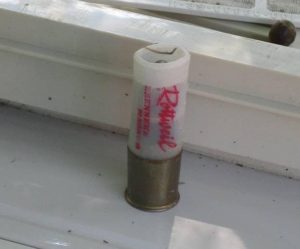
The shotgun shell.
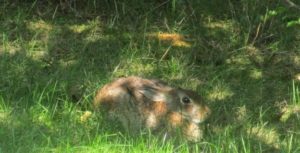
My rabbit friend. Was it warning me about the shotgun shell?
FLOWERING HIGHTSTOWN: One of my regular stops is the Hightstown Diner, where Kathy and George Antonellos have been great hosts over the decades in their 1941 diner. What I notice when I visit the diner is the flowers in this quaint, historic Mercer County town. So, I walked about, shooting photos of them. (If you like South Jersey-Philadelphia scrapple, the Hightstown Diner has it – one of the northernmost locations where scrapple can be found. Me, I love scrapple!)
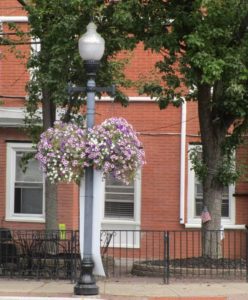
The corner of Mercer Street (Route 33) and Rogers Avenue in Hightstown, Mercer County.
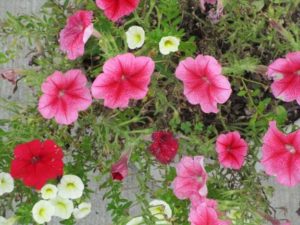
Along Mercer Street (Route 33) in Hightstown, Mercer County.
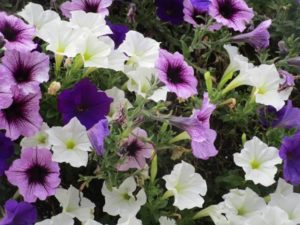
Flowering Hightstown.
DRIVE-BY NATURALIST, A GREAT EGRET: As I was driving home from Hightstown, I crossed the Millstone River, the boundary of East Windsor, Mercer County, and Cranbury, Middlesex County. There, I noticed a perched great egret, “Ardea alba.” Keep an eye out for nature. It is all around us.
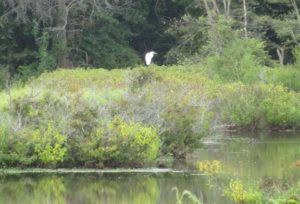
A great egret on the Millstone River. Here, the river is the boundary of East Windsor, Mercer County, and Cranbury, Middlesex County.
OCEAN TEMPERATURES: Atlantic Ocean temperatures on the New Jersey coast were about 72 degrees Friday, September 15.
SUNRISE/SUNSET: For September 17, Sunday, to September 23, Saturday, the sun will rise about 6:40 to 6:45 and set about 6:55 to 7:05. The fall equinox of nearly equal daylight and sunlight is September 22, Friday. For September 24, Sunday, to September 30, Saturday, the sun will rise about 6:50 a.m. and set about 6:45 p.m.
THE NIGHT SKY: The new moon is September 20, Wednesday. The next full moon is the Full Harvest Moon October 5, Thursday.
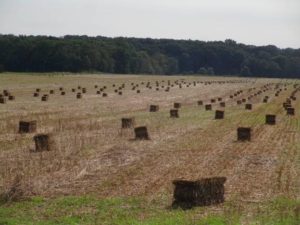
Harvest time it is. Here, hay being harvested on a farm in Cranbury, Middlesex County.
WEATHER: The National Weather Service forecasting station for the area is at http://www.weather.gov/phi/.
Joe Sapia, 60, is a lifelong Monroe resident. He is a Pine Barrens naturalist and an organic vegetable-fruit gardener. He gardens the same backyard plot as did his Italian-American father, Joe Sr., and his Polish-immigrant, maternal grandmother, Annie Poznanski Onda. Both are inspirations for his food gardening. Joe is active with the Rutgers University Master Gardeners/Middlesex County program. He draws inspiration on the Pine Barrens around Helmetta from his mother, Sophie Onda Sapia, who lived her whole life in these Pines, and his Grandma Annie. Joe’s work also is at @JosephSapia on Twitter.com, along with Facebook.com on the Jersey Midlands page.
Article and photos by Joe Sapia
Note: The yard references are to my house in the section of Monroe between Helmetta and Jamesburg in South Middlesex County. My yard is in a Pine Barrens outlier on the Inner Coastal Plain, the soil is loamy, and my neighborhood is on the boundary of Gardening Zones 6b (cooler) and 7a (warmer). Notes and photographs are for the period covered, unless otherwise noted.
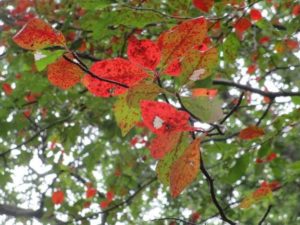 A black gum, “Nyssa sylvattica,” changes color at Cranberry Bog in the Pine Barrens around Helmetta.
A black gum, “Nyssa sylvattica,” changes color at Cranberry Bog in the Pine Barrens around Helmetta.
CHANGING COLORS IN THE PINE BARRENS AROUND HELMETTA: Black gum trees, ““Nyssa sylvattica,” are obvious with their leaves changing colors for the season. “Fall foliage,” meaning the changing colors as colder weather approaches, is a misnomer, because, here, in the Pine Barrens around Helmetta, changing colors are noticeable beginning about July 15 to 31. I look for the peak of the coloring October 13 in wet areas and October 20 in dry areas, but, really, it is impossible to pinpoint a peak. If there is even a peak, because there may not be a uniform turning of colors.
“OPIENKI” MUSHROOMS, PINE BARRENS AROUND HELMETTA: As I drove a paved road through Jamesburg Park today, I saw a car parked at the woods and a woman at the car. She wore yoga pants, a short-sleeve pullover shirt, and sneakers, pants untucked — not really dressed as a woodswoman. So, I took a guess at what she was doing.
Mushrooms? I asked.
She said yes.
What kind, honey mushrooms?, I said.
The woman — Lana, who lived a few miles away from the site — said she did not know the name to tell me. Then, I noticed what sounded to be an Eastern European accent.
“Opienki”? I asked.
Yes, she smiled. How did you know that name?
A grandmother from Poland, I said.
Lana is from the Ukraine. She was picking edible mushrooms of the genus “Armillaria,” known by Polish people as “opienka” singular and “opienki” plural. “Pien” means stump in Polish and these mushrooms grow along the stumps of dead oaks. Hence, they also are known as “stumpies” — and “tan and yellow stumpies” because of their color and, of course, where they are found. But the general public probably would know them best by their common name, “honey mushrooms.”
Lana had bags filled with mushrooms in her car. (See the photos, which she let me take.)
Journalisticly, I am publishing this to inform people. In a neighborly way, I am hesitant to publish this because PICK THE WRONG MUSHROOM AND, AT BEST, YOU WILL GET SICK, AND, AT WORST, YOU WILL DIE.
I am 60-years-old and have been in these woods my whole life, and have heard stories from them going back another 50 or 60 years to when my maternal family settled here, and I will confidently pick ONLY ONE mushroom in the Pine Barrens around Helmetta: opienka. In the Jersey Midlands as a whole, I will confidently pick ONLY TWO: the second one, a morel, which I am familiar with on the Piedmont — say, at such areas as Princeton and Sourland Mountain.
I am “somewhat confident” to pick two more. But I made it to 60 and “somewhat confident” does not cut it. Remember the adage: There are bold mushroom pickers and there are old mushroom pickers. There are no old AND bold mushroom pickers.
If one must pick mushrooms, three bits of advice, even for the experienced picker: One, know how to call emergency responders, telephone 911; two, the telephone number of New Jersey Poison Control, 800-222-1222; and three, save one mushroom, perhaps on your kitchen counter, so doctors know the mushroom one ate.
I said good-bye to Lana, warning her of ticks, which can pass along disease such as Lyme, and chiggers, which will get one itching, beginning about 36 hours after leaving the woods, and scratching like crazy for days. (Me, man who got chiggers a week ago, here, in the Pine Barrens around Helmetta. Me, stupid man because I was not thinking and did not avoid grassy areas.)
(Dedicated to Grandma Annie Poznanski Onda, born 1885 in Poland, died 1972 in the Pine Barrens around Helmetta. And a big thank you to Ralph “Rusty” Richards, woodsman extraordinaire of the Pine Barrens around Helmetta, who continues to be a local woods mentor to me.)
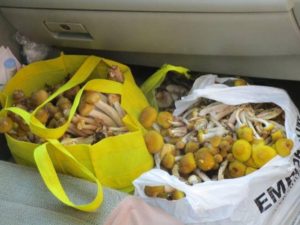
Lana’s “opienki” mushrooms in the Pine Barrens around Helmetta.
ALSO IN THE PINE BARRENS AROUND HELMETTA: Look for fall bloomers, such as asters. Joe Pye weed, “Eutrochium purpureum,” remains blooming – and will do so until about October. Queen Anne’s lace, “Daucus carota,” continues blooming to about November. The seed heads of punks, or cat-tails, genus “Typha,” were fluffing as summer passes.
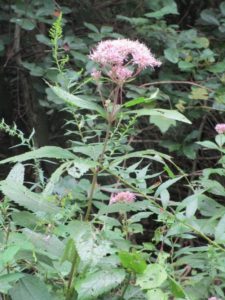
Joe Pye weed in bloom near the Ditch in the Pine Barrens around Helmetta.
CHIGGERS IN THE PINE BARRENS AROUND HELMETTA: I did a brief hike Friday, Sept. 1, and began itching around Sunday morning – chigger bites! Fortunately, I did not get a bad case, a bit of itching here and there on my legs. I first encountered chiggers, here, in about 2004. Some view chiggers as a Southern species moving north; Others will say we already had them up here. I knew of chiggers from hiking in the Pine Barrens down in South Jersey. The bottom line is they itch! So, I will scratch for a few days, then life will go on until the next round of chiggers. (A tip: Avoid grassy areas such as those I walked in on my hike. I just was not thinking.)
MA, GRANDPA, AND THE LOCAL PINE BARRENS: Perhaps I was not thinking of chiggers on Sept. 1 because my mind was elsewhere. Earlier that day, I had mailed in a donation to my church, Holy Trinity Roman Catholic Church in Helmetta, and a request for a Mass to be said in Grandpa Mike Onda’s honor October 11– the 100th anniversary of his death in Helmetta from tuberculosis at 35–years-old. He left a 32-year-old widow, Annie Poznanski Onda, and three children 5-years-old and younger. One of those children was my mother, Sophie Onda Sapia, who was 3 when her father died. Her only memory of her father in later years was of her with him at Shekiro’s Pond in Helmetta. September 1 was the 22nd anniversary of Ma’s death at 81 in 1995. On this anniversary, I visited Shekiro’s Pond.
PESTS IN THE YARD: Neighbor Tom DeRose contacted me on the night of Labor Day, wanting to show me something in his yard. So, in the dark with flashlights, Tom and I were looking into a hole – perhaps big enough to shove in a few golf balls – of yellow jacket wasps. Ugh! They have scared me since I was a kid playing Army in this same neighborhood with Eddie Kasubinski. I pointed down the street at “The Swamp,” where Eddie and I got attacked – not by an opposing army, but by “yellow jacks.” I ran up the street crying. My father heard me, rushed into the backyard, saw the yellow jacks attacking me, grabbed my Army jacket, which had yellow jacks in it, and threw it aside. A number flew out of the jacket. I had got stung twice. Yellow jacks can be aggressive and multiple stingers. So, I advised Tom to stay away from his side yard until the cold weather sets in or spray a pesticide into the hole.
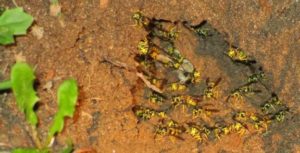
The yellow jacket nest in Tom DeRose and Trisha Miller DeRose’s side yard.
LAURINO FARMS: I was out in Monmouth County and stopped by Laurino Farms on Route 537 (between Laird and Swimming River Roads) in Colts Neck. There, I picked up a favorite of mine, white peaches, along with a jar of cranberry preserves. A shout out to Bobby Laurino, whom I saw briefly – personally, Bobby has patiently answered my gardening questions and he is an inspiration for me growing zinnias this year. And, more importantly, a shout out to Bobby for what he does for feeding the needy, including helping the Soul Kitchen restaurants (www.jbjsoulkitchen.org) in Red Bank and Toms River, founded by rock and roll star Jon Bon Jovi and his wife, Dorothea Bongiovi, who live in Middletown, Monmouth County, to support the needy. For example, Laurino provides space at his farm for Soul Kitchen to grow food organically. Dorothea said, “Bobby is an amazingly generous person, not only with his contribution of land to the Soul Kitchen so we could raise our own vegetables, (but) he is generous with his time, his knowledge, his spirit. I am not sure if all farmers are as optimistic as Bobby, but he has a positive can-do attitude that maybe all farmers need. Farming is an unbelievably difficult life, with many uncontrollable variables: temperature, rain, sun, insects (Bobby does not use pesticides), animals. I have enormous respect for anyone who grows food for others.” (And a shout out to Dorothea, who handles herself with class and humility. Over the summer, Dorothea received a Volunteer Leadership Award in the New Jersey State Governor’s Jefferson Awards for Public Service for her work with Soul Kitchen. “I was very surprised and humbled by the Jefferson award,” Dorothea said.)
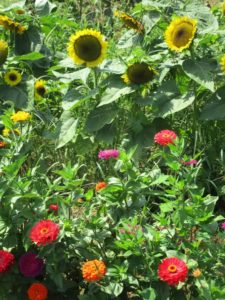
Zinnias and sunflowers at Laurino Farms in Colts Neck, Monmouth County.
DRIVE-BY NATURALIST, “BIDENS” FLOWERS: Although I know the yellow flowers of the genus “Bidens” are adorning unplowed farmland and disturbed areas, it still amazes me when I come across fields of these flowers. I was driving in southern Monroe and came across this batch, next to acres of soybeans.
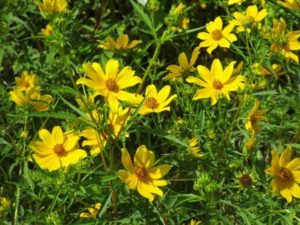
Yellow flowers of the genus “Bidens” in southern Monroe.
IN THE YARD AND GARDEN: The zinnias and Knock Out roses continue to bloom earnestly.
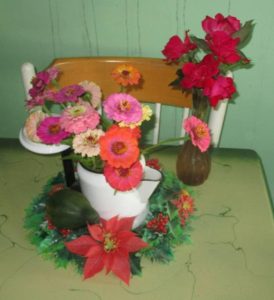
Zinnias, Knock Out roses, and a gourd, all from the my yard or garden, decorate the antique porcelain-top table in my kitchen. One of Ma’s old coffeepots is used as a vase.
MY BELOVED ZINNIAS: While still flowering wonderfully, the zinnias appear to have contracted powdery mildew. So, I will be dealing with this.
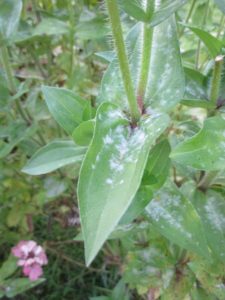
Apparently powdery mildew on the zinnias.
IN THE GARDEN: My summer crop, except for the zinnias, was a disaster. The sweet corn was undeveloped, probably because of too much rain and I should have planted in a bigger block to foster pollination, but it was harvestable and tasty. Too much rain translated into no cucumbers, no cantaloupe. Very few tomatoes, because something ate the tops off the plants.
MECHKOWSKI FARM: Timmy Mechkowski farms in Helmetta. He reported good crops of sweet corn, beets, stringbeans, carrots, broccoli, cabbage, and onions. “Tomatoes were decent until the end, when we starting getting the rain.” Timmy reported a bad year for peppers, potatoes, and blackberries. The Mechkowski farm is one of my favorite places.

Sitting on the front porch of his house, Timmy Mechkowski goes over his planting list.

Timmy Mechkowski’s dog, Abby, probably the most beautiful and most gentle dog I have ever met.
NAVESINK RIVER: The Navesink River drains about 95 square miles in the Red Bank area of Monmouth County. It abuts the hilly geological formation that separates the Inner and Outer Coastal Plains. The river sits on the Outer Coastal Plain side. These photos were taken downstream of the Ocean Bridge from the Middletown side. The bridge connects Middletown and Rumson. The Navesink River is one of my favorite places in the Jersey Midlands.

On the Navesink River, looking toward the Oceanic Bridge connecting Rumson, left, and Middletown, right.
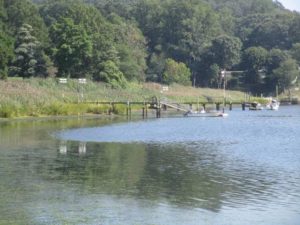
Along the Navesink River.
DRIVE-BY NATURALIST, GREAT BLUE HERON: As I was leaving the Navesink River, I noticed a great blue heron, “Ardea Herodias” – a large bird I am in awe of.
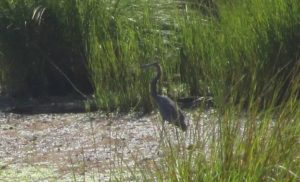
The great blue heron along the Navesink River.
BIG SKY COUNTRY, MONROE TOWNSHIP: As the Jersey Midlands continue to develop, there is more a loss of big sky views. But the area between the Applegarth and Wyckoff’s Mills sections of Monroe is still a holdout. Here, there are wonderful views over soy bean fields and cornfields.
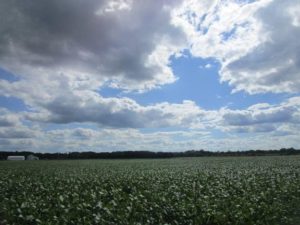
Between Monroe’s Applegarth and Wyckoff’s Mills sections, looking over a soybean field toward Route 33.

Between Monroe’s Applegarth and Wyckoff’s Mills sections, looking toward Cranbury, with corn growing to the right and soybeans to the left.
THE FLIP SIDE OF BAMBI: I have published photographs of beautiful deer in nature. I need to point out the flip side: deer on farmland and in garden. Years ago, I was talking to a farmer who grew corn on the state’s Assunpink Wildlife Management Area in western Monmouth County. The farmer paid no rent, but he had to leave a percentage of his crop to feed wildlife. The way I recall the story: “The problem is,” the farmer said, “the deer don’t know which 75 percent is mine and which 25 percent is theirs.” As Jersey Midlands nature writer John McPhee has written, “Deer, in my opinion, are rats with antlers, roaches with split hooves, denizens of the dark primeval suburbs. Deer intensely suggest New Jersey.”
OCEAN TEMPERATURES: Atlantic Ocean temperatures on the New Jersey coast were in the range of about 69 to 72 degrees during the weekend of September 9-10.
SUNRISE/SUNSET: For September 10, Sunday, to September 16, Saturday, the sun will rise about 6:35 to 6:40 a.m. and set about 7:10. For September 17, Sunday, to September 23, Saturday, the sun will rise about 6:40 to 6:45 and set about 6:55 to 7:05. The fall equinox of nearly equal daylight and sunlight is September 22, Friday.
THE NIGHT SKY: This week, in the pre-sunrise sky, I saw the constellation Orion for the first time this season – Colder weather is coming with the winter constellations. The moon is waning after the September 6 full moon. The new moon is September 20, Wednesday. The next full moon is the Full Harvest Moon October 5, Thursday.
WEATHER: The National Weather Service forecasting station for the area is at http://www.weather.gov/phi/.

Joey’s zinnias at the Hightstown Diner, in Hightstown, Mercer County.
Joe Sapia, 60, is a lifelong Monroe resident. He is a Pine Barrens naturalist and an organic vegetable-fruit gardener. He gardens the same backyard plot as did his Italian-American father, Joe Sr., and his Polish-immigrant, maternal grandmother, Annie Poznanski Onda. Both are inspirations for his food gardening. Joe is active with the Rutgers University Master Gardeners/Middlesex County program. He draws inspiration on the Pine Barrens around Helmetta from his mother, Sophie Onda Sapia, who lived her whole life in these Pines, and his Grandma Annie. Joe’s work also is at @JosephSapia on Twitter.com, along with Facebook.com on the Jersey Midlands page.
Article and photos by Joe Mish
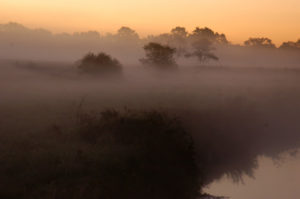 An orange sky rests upon the impenetrable white fog as dawn breaks over Holland brook on the first day of September. The predawn landscape is shrouded in a heavy mist so deep, only the treetops can be seen.
An orange sky rests upon the impenetrable white fog as dawn breaks over Holland brook on the first day of September. The predawn landscape is shrouded in a heavy mist so deep, only the treetops can be seen.
As September exhales the last warm breath of summer, it begins to inhale cool autumn air in a respiratory sequence of endless seasonal change.
With barely 9 days of autumn out of 30, the title to September is in summer’s name, despite the lien filed by fall for possession. The struggle that ensues is openly expressed in fits of alternate ownership, where autumn takes over with chilly nights while summer responds with beautiful warm days, indistinguishable from its July and August menu.
The engagement of warm summer days and cool autumn nights, in a battle for dominance, leaves the river’s flood plain covered with heavy morning mist. The impenetrable white fog hides everything except isolated tree tops to give the impression of a primordial soup that first gave rise to life on earth.
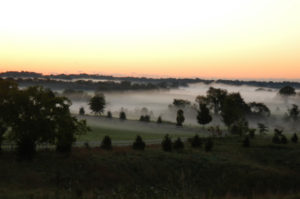
White mist rising up from the South Branch, submerges trees in a dense early morning fog, characteristic of the drastic day and night temperature changes in early fall.
As autumn appeals its case to the heavens, the sun begins to shift its position and rides lower in the sky, away from its high summer orbit. Evidence of this collusion is signaled as the dawn light colors the morning mist with every tint from gold thru orange to deep purple; a precursor to the colorful foliage that defines the fall season. The colors signal another vote for autumn’s plan to own September.
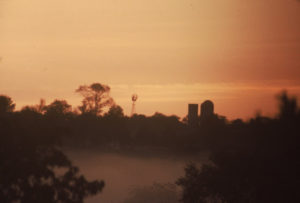
Except for the silhouette of farm building on the high ground, this scene has played out along the South Branch for thousands of years when autumn approaches.
Ultimately it is the stars in the heavens which have the final say, as they align to signal the exact moment of the autumnal equinox to find in fall’s favor. There is no chance of appeal, though summer still resists.
Offering blue skies and warm days, scraped from the bottom of it’s now empty quiver, summer attempts to keep the foliage from changing to a colorful no vote.
First to buy into autumn’s argument is Virginia creeper and poison ivy. Summer ignores their decision and counters that vines showed color back in August. A time clearly owned by summer and validated by consensus. It is when the black gum trees’ leaves began to turn a bright salmon color that summer’s brave stance began to waver. Here was a tree whose leaves began to light up the greenery like old fashioned lights tacked to the porch rail to celebrate the holiday season. Once the trees began to turn, summer knew its days were numbered.
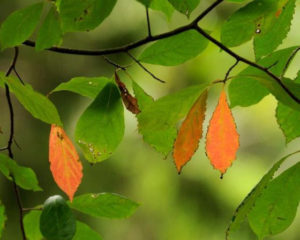
Black gum leaves mark the beginning of nature’s display of autumn color.
The stalwart oaks were the next to be counted as they sounded in favor of autumn, treating each fallen acorn as a separate vote. The deer found in favor of summer and began to eat all the fallen acorns in an attempt to cancel the oaks’ ballots. If summer was hard of hearing and the polling place rife with fraud, the oaks along with the sweet gum trees blinded the hillsides with color. Deep scarlet red oak leaves combined with a brilliant array of yellow, purple and old rose, star shaped sweet gum leaves. Norway and sugar maples chimed in with fluorescent red and yellow leaves. The final tally was overwhelming, a landslide in favor of autumn’s claim to September and an end to summer’s futile efforts to hang on.
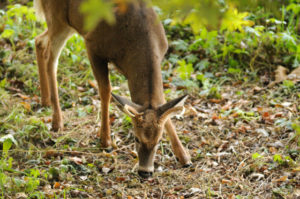
A young buck searches the ground for acorns in early September. Acorns are the number one food that deer love. when you see deer hanging around under a tree in early fall, notice that tree is more than likely an oak. Deer dine as we are supposed to, they eat what is in season.
Summer looked upon the flowers of the field to see the drooping heads and faded colors of the delicate muses it so carefully nurtured and who, in return, stood by summer’s side until their death. Summer was finally moved to surrender its claim of September to autumn. With a last warm breath, summer whispered a vow to return, even before the final days of the next spring.
Author Joe Mish has been running wild in New Jersey since childhood when he found ways to escape his mother’s watchful eyes. He continues to trek the swamps, rivers and thickets seeking to share, with the residents and visitors, all of the state’s natural beauty hidden within full view. To read more of his writing and view more of his gorgeous photographs visit Winter Bear Rising, his wordpress blog. Joe’s series “Nature on the Raritan, Hidden in Plain View” runs monthly as part of the LRWP “Voices of the Watershed” series. Writing and photos used with permission from the author.



































































































































